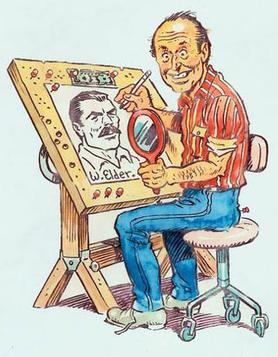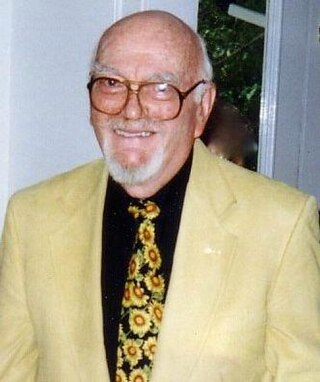
Mad is an American humor magazine first published in 1952. It was founded by editor Harvey Kurtzman and publisher William Gaines, launched as a comic book series before it became a magazine. It was widely imitated and influential, affecting satirical media, as well as the cultural landscape of the 20th century, with editor Al Feldstein increasing readership to more than two million during its 1973–1974 circulation peak.

Dave Berg was an American cartoonist, most noted for his five decades of work in Mad of which The Lighter Side of... was the most famous.

Crazy Magazine is an illustrated satire and humor magazine that was published by Marvel Comics from 1973 to 1983 for a total of 94 regular issues. It was preceded by two standard-format comic books titled Crazy. The magazine's format followed in the tradition of Mad, Sick, Cracked and National Lampoon.

Harvey Kurtzman was an American cartoonist and editor. His best-known work includes writing and editing the parodic comic book Mad from 1952 until 1956, and writing the Little Annie Fanny strips in Playboy from 1962 until 1988. His work is noted for its satire and parody of popular culture, social critique, and attention to detail. Kurtzman's working method has been likened to that of an auteur, and he expected those who illustrated his stories to follow his layouts strictly.

The Mad Fold-In is a feature of the American humor and satire magazine Mad. Written and drawn by Al Jaffee until 2020, and by Johnny Sampson thereafter, the Fold-In is one of the most well-known aspects of the magazine, having appeared in nearly every issue of the magazine starting in 1964. The feature was conceived in response to centerfolds in popular magazines, particularly Playboy.
Spy vs. Spy is a wordless comic strip published in Mad magazine. It features two agents involved in stereotypical and comical espionage activities. One is dressed in white, and the other in black, but they are otherwise identical, and are particularly known for their long, beaklike heads and their white pupils and black sclera. The pair are always at war with each other, using a variety of booby traps to inflict harm on the other. The spies usually alternate between victory and defeat with each new strip. A parody of the political ideologies of the Cold War, the strip was created by Cuban expatriate cartoonist Antonio Prohías, and debuted in Mad #60, dated January 1961. Spy vs. Spy is currently written and drawn by Peter Kuper.
Antonio Prohías was a Cuban-American cartoonist. He was the creator of the satirical comic strip Spy vs. Spy, which he illustrated for Mad magazine from 1961 to 1987.

William Elder was an American illustrator and comic book artist who worked in numerous areas of commercial art but is best known for a frantically funny cartoon style that helped launch Harvey Kurtzman's Mad comic book in 1952.
Nick Meglin was an American writer, humorist, and artist. He was known for his work as a contributor, comics writer, illustrator and editor for the satirical magazine Mad. He also scripted Superfan, a 1970s comic strip by Jack Davis. He was active as a lyricist of musical theatre, and had columns in various specialized magazines about culture and sports.

John Ficarra is an American publishing figure. He was hired as assistant editor of the American satire magazine Mad in 1980, shortly after his debut as a contributing writer. He became editor-in-chief in 1985, when the incumbent retired, to 2018.

Robert J. "Bob" Clarke was an American illustrator whose work appeared in advertisements and MAD Magazine. The label of the Cutty Sark bottle is his creation. Clarke was born in Mamaroneck, New York. He resided in Seaford, Delaware.

Tom Richmond is an American freelance humorous illustrator, cartoonist and caricaturist whose work has appeared in many national and international publications since 1990. He was chosen as the 2011 "Outstanding Cartoonist of the Year", also known as "The Reuben Award", winner by the National Cartoonists Society.
Dean Rankine is an Australian comics artist, writer and illustrator. Rankine's work has appeared in many comics, books and magazines.
Debuting in August 1952, Mad began as a comic book, part of the EC line published from offices on Lafayette Street in Lower Manhattan. In 1961 Mad moved its offices to mid-town Manhattan, and from 1996 onwards it was located at 1700 Broadway until 2018 when it moved to Los Angeles, California to coincide with a new editor and a reboot to issue #1.
Mad is known for many regular and semi-regular recurring features in its pages.
Archie's Mad House was a comic book magazine published by Archie Comics from 1959 to 1982. The series went through a number of overhauls and name changes. Classic stories have occasionally appeared in digest magazines.

"The Simpsons Guy" is the first episode of the thirteenth season of the American animated television series Family Guy, and the 232nd overall episode. It is a 44-minute-long crossover with The Simpsons, and was written by Patrick Meighan and directed by Peter Shin. It originally aired in the United States on September 28, 2014, on Fox, where both The Simpsons and Family Guy have aired since their respective debuts.

American cartoonist Harvey Kurtzman was the founding editor and primary writer for the humor periodical Mad from its founding in 1952 until its 28th issue in 1956. Featuring pop-culture parodies and social satire, what began as a color comic book became a black-and-white magazine with its 24th issue.

Alfred E. Neuman is the fictitious mascot and cover boy of the American humor magazine Mad. The character's distinct smiling face, parted red hair, gap-tooth smile, freckles, protruding ears, and scrawny body first emerged in U.S. iconography decades prior to his association with the magazine, appearing in late 19th-century advertisements for painless dentistry – the origin of his "What, me worry?" motto. The magazine's editor, Harvey Kurtzman, claimed the character in 1954, and he was named "Alfred E. Neuman" by Mad's second editor, Al Feldstein, in 1956. Since his debut in Mad, Neuman's likeness has appeared on the cover of all but a handful of the magazine's over 550 issues. Rarely seen in profile, Neuman has almost always been recognizable in front view, silhouette, or directly from behind.

Pop culture fiction is a genre of fiction where stories are written intentionally to be filled with references from other works and media. Stories in this genre are focused solely on using popular culture references.